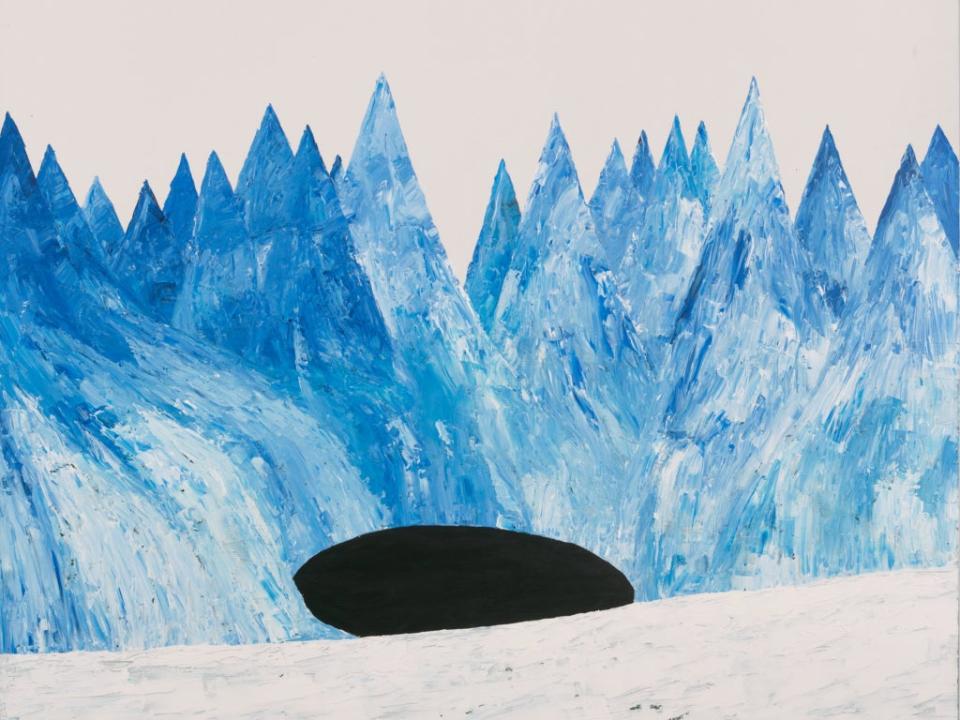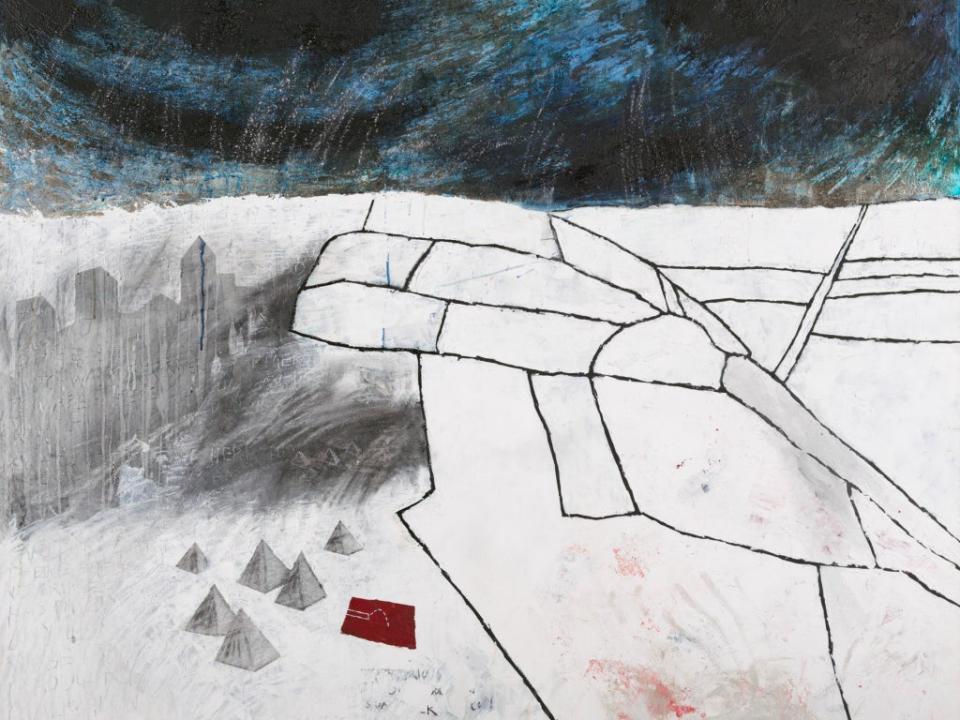The art of Radiohead’s ‘Kid A’ and ‘Amnesiac’: ‘We were all in a state of wild madness’

“I don’t think anyone is prepared for fame and all the things that come with it,” says long-term Radiohead collaborator Stanley Donwood. The visual artist should know: he has created all their album covers to date and was there to witness how shell-shocked the group were following the success of their third album, 1997’s OK Computer. “Everyone thinks fame is great but it’s very weird. Psychologically, being famous put them into a really strange place.”
In 2017, when the 20th anniversary of the album arrived (and compilation OKNOTOK was released), frontman Thom Yorke said the experience had left him “catatonic”. “I was sort of trapped in my own particular labyrinth, followed by this weird sort of [inner] monologue, a criticism of everything I did,” he explained recently, saying his confidence had plummeted. “It … shut me down, and whenever I tried to write something … to sit down in front of any instrument, I sort of froze.”
Out of Yorke’s writer’s block came the two rip-it-up-and-start-again albums, Kid A and Amnesiac, within a year of each other, which are getting a joint 21st anniversary release this week. An exhibition of Donwood’s accompanying artwork is also on display at Christie’s in London, and he and Yorke have worked on two books recounting the album sessions in detail.
“It was quite a claustrophobic process,” says Donwood, calling from his Brighton studio, where he has spent the last few years busily sifting through hundreds of artworks he created with the group. “By the end of it, we were all in a state of almost wild madness.”

To understand what happened during the Kid A to Amnesiac period between 2000 and 2001, Donwood says you have to go back to the OK Computer era that preceded it. After the group had what he describes as “medium success” with 1995’s The Bends, OK Computer took them to dizzying heights, especially after their headline slot at Glastonbury 1997, still regarded as one of the best in the festival’s history.
A huge, critically acclaimed tour followed, including more than 110 dates in the US alone. “It was a big step change for them,” Donwood says. “Thom and the band were knackered. The tour just kept getting bigger and bigger because each show was a sell-out. There were more dates, more travelling, more time away.”
When Radiohead released a demo-drop of over 18 hours’ worth of outtakes from the OK Computer sessions in 2018, it also revealed a conflict that emerged long before their discomfort with the music circus. While their major label wanted them to emulate the guitar-driven success of The Bends, the band vehemently did not, looking instead to the burgeoning electronic era, which was taking influence from more avant-garde styles like Krautrock and jazz.
That combination can be heard on one of the earliest versions of “True Love Waits” from the OK sessions, a significant recording that hinted at where the group wanted to go. Bursting into a vast electronic soundscape mid-song, like those later heard on Kid A and Amnesiac, it eventually collapses under the weight of the nervously twisting melodies. While the song was abandoned at the time, it was a glimpse into the mindset of a group in the middle of a huge creative left turn.
With Yorke unable to write or play early in 1998 because of his ongoing writer’s block, he turned to his old art-college friend Donwood for help. He’d been spurred on by his partner at the time, the late Rachel Owen, who had urged him to go back to his roots. Donwood encouraged Yorke to paint and create sketchbooks of ideas, and soon he’d filled dozens.
“We were quite obsessively clipping pieces out of newspapers and sticking them into our sketchbooks,” Donwood recalls. “They were in amongst all these drawings, diagrams and ideas. Everything at the time kind of fed into this maelstrom of information we had swirling around, almost like a kind of storm around us. We’d grab bits, pull them out and try to stick them down.”
That maelstrom of information came in the “really weird time” leading up to the new millennium. “People were going mad,” Donwood says with a laugh. “It was almost medieval – the sun was going to go out forever because of the solar eclipse, all of the planes were going to fall out of the sky because of the millennium bug. It was really apocalyptic.”

One of the biggest influences on the sketchbooks, he says, was the introduction of the internet, then only a few years old. “News had made the leap from broadcast media to the internet, and suddenly you didn’t get the news compartmentalised between light entertainment programmes,” Donwood remembers.
“There was a lot more information to digest, and crucially, a lot more images for the first time, too: the war in Yugoslavia, ethnic tensions, godawful genocide in Africa – it suddenly exploded, and war was on our doorstep. For the first time, the imagery of war hadn’t been censored, or put through any kind of gatekeeper. The internet then was very unregulated.”
Another influence, Donwood says, was the environment, with Yorke becoming increasingly fearful of climate change. “Both of us had been on the more ecologically aware side of politics for a long time, and all the stuff was coming out then about the ice melt, global warming,” says Donwood. “There’s all this stuff about it now, but it felt so urgent then too.”
Yorke found himself spending more time among landscapes and nature as a result, including a lengthy period in Cornwall, where he would roam the moors for hours, drawing in his sketchbook as he went. Images of the future started to emerge in their sketchbooks: they were nightmarish, with images of monsters and pyramids (a symbol of power, Yorke said) looming heavily over vast mountainous regions, Yorke and Donwood lost among it all.
With ideas starting to percolate, Radiohead eventually purchased a new recording space, following failed stints in both Paris and Copenhagen. “With all the money from OK Computer, they bought this big complex of barns in Oxfordshire,” Donwood explains. “They’d only had a mobile recording studio prior to this, and now, suddenly, we had this singular, more [isolated] place to work in.”
Donwood had his own area to paint, as did Yorke, and the working space was more immersive than they’d ever had previously. A complete media blackout ensued, and the group were also left alone by their record company. For the first time, they were free from time constraints.

What was it like when they started to create? “A lot of time was [spent] just flailing around,” Donwood recalls. “Like clouds of dust in a vacuum cleaner or something.” It took time for any work to emerge. When the music came, some months later, Donwood started to paint huge canvases depicting “fire and ice”. Once he shared his paintings with the group, more songs emerged and the relationship between the two became more symbiotic than ever.
“If I’m on my own I can very easily disappear into some sort of rabbit hole or vortex,” Donwood says, “but when there’s music playing, when I’m working with someone else, the music is another voice and I can listen to it and it can tell me what to do. The music’s already made the artwork in a way; I’ve just got to find out what that looks like.”
What emerged in the case of Kid A were dark, dystopic images of distorted, jagged mountainous regions, digitally stretched out of all proportion to reflect multiple apprehensions. There was the new millennium, the ongoing war in Yugoslavia, looming climate change (some of the mountains are drawn aflame) and the apprehension of the group themselves – the mountains were also metaphors for the increasing pressures they faced.
“I’m lost at sea / don’t bother me / I’ve lost my way”, Yorke crushingly sings on “In Limbo”; “I’m not here / This isn’t happening”, he adds on the gentle “How To Disappear Completely”. Lyrics and melody were deconstructed to reflect Radiohead’s confusion and growing anxiety at the world, and while songs were sparser, they still somehow soared as Yorke found his voice once more. The freedom that came with ditching their guitars was also palpable.
On Kid A’s artwork, there were frequent snatches of menace within the landscape, such as overpowering pylons, pyramids (representing power), and pools of blood. Donwood says these were “stalking creatures” or metaphors for the pressures of the era. The idea is continued on 2001’s Amnesiac, but Donwood took things a step further, with a central picture of a minotaur. “I wanted Amnesiac to look really different to the first half [Kid A],” Donwood says. “The minotaur is the central tragic figure in the centre of the artwork. It was the idea that we are the monster trapped in a maze of our own creation. It’s this imaginary prison we’ve made.”
That “monster trapped” idea came out, in part, of Yorke’s lyrics on Amnesiac, such as those in “Knives Out”, when after two years of hassle, the group had finally escaped their own metaphorical prison. Yorke sings “I’m not coming back” on that, and on “Pyramid Song” he repeats: “There was nothing to fear and nothing to doubt”. Amnesiac’s material, which arrived towards the end of the sessions, pushed the experimentation of Kid A further, and shows Radiohead moving assuredly into their new era, after two years of trying to get there.

While the albums have been combined into one for this anniversary release, Donwood says he still sees them as separate entities. “Personally, I felt they were really distinct,” he says. “They were divided by artistic intent and in time as well. They sort of developed a very different meaning to one another.”
Indeed, “Kid Amnesiae” – a third record in the anniversary collection, containing previously unreleased material from both albums – underscores this difference between the two: Kid A’s outtakes feeling edgier; Amnesiac’s feeling assured.
There’s the grungy guitar-led “Follow Me Around”, which shows them starkly transitioning from OK to Kid A and a futuristic version of “Pulk/Pull (True Love Waits Version)”, hinting at their sparse A Moon Shaped Pool future – it felt too futuristic even for Amnesiac at this stage. Cohesive versions of “Like Spinning Plates” and “Follow Me Around” sound overly structured (and commercial) for what both albums eventually became: leaving these out shows a group determined to confine melody to the vaults.
“Kid A was the first record they made where I was like, ‘Yeah, all of this is great!’,” Donwood says, looking back with fleeting fondness to the end result, but ever aware of the challenges it took to get there. When Kid A and later Amnesiac were released, the group lost a plethora of fans who had not yet accepted that guitar music was dying, only for many to come back years later once they realised it had. It may have been a difficult transition for the band and their fans, but the records stood the test of time musically and thematically: both are still as relevant and as futuristic-sounding today as they were then.
For Donwood, though, the music will always be inextricably tied to the images. “I find it hard to look at these paintings without hearing the music,” he says. “It’s kind of in them; it’s encoded.”
The ‘Kid A Mnesia’ 21st Anniversary triple album is out now on XL Recordings
Read More
The five best new books to read this month
Whitesnake’s David Coverdale: ‘I wrote ‘Here I Go Again’ rat-arsed on port and 7 Up’
The 40 best song lyrics of all time
Whitesnake’s David Coverdale: ‘I wrote ‘Here I Go Again’ rat-arsed on port and 7 Up’
The 40 best song lyrics of all time
We need more than sympathetic performers to avoid another tragedy like Astroworld

 Yahoo News
Yahoo News 